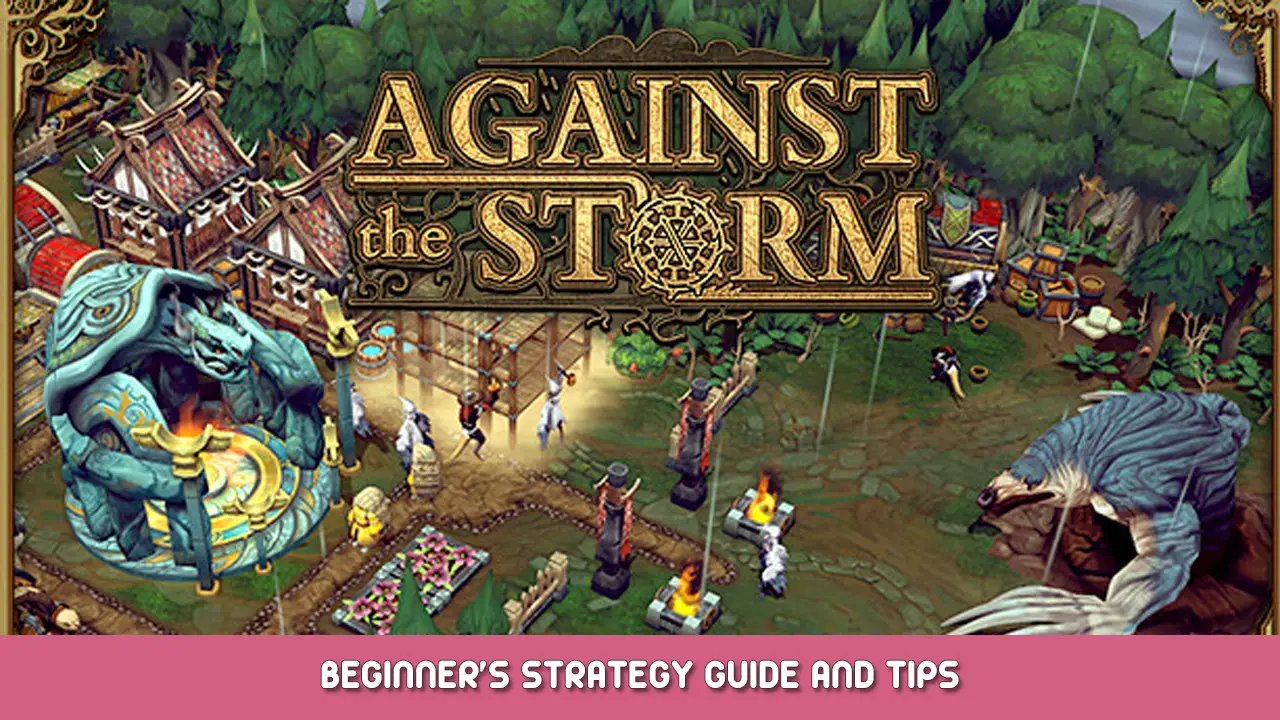These are the general steps I follow every game and it has worked for me up to Prestige level 13.
ゲーム序盤 – basic production, ハウジング
- Start by setting up production of basic resources: 木材, stone/clay, reed/plant fiber. I like to start with 2 Woodcutter camps, ある Crude workstation and one other camp, depending on the available resources.
- For the Woodcutter camps, tick the box “avoid opening glades (unless marked)” so you won’t have to deal with glade events because you opened a glade accidentally.
- From the starting blueprints, I usually pick 2 or 3-star buildings for making planks/bricks/fabric. しかし, I don’t like the Workshop since there is no faction bonus and it only takes 2 労働者.
- Pick the blueprints that synergize well with your factions, preferably those with a 10% chance of double yield.
- Build housing for your factions. If you lack resources, just build a big shelter and fix it later.
- Make sure to build a Blight post by now. Assign Harpies if possible and set a limit to Purging Fire production that is slightly higher than the number of Blight Cysts so you don’t waste more wood than necessary. Villagers leaving or dying to Blightrot will stagnate your progress!
- Upgrade your hearth to an Encampment (建てる 4 decorations and housing for 8 村人).
This should get you through the first year. See what 注文 you can complete during the first few years, sometimes you get lucky and get some easy ones (opening glades, making 5 packs of trade goods).
ゲーム中盤 – opening glades, advanced production
- Check which natural resources are on the map. You will need either 銅鉱石 または Crystalized Dew in order to make Simple Tools.
- Crystalized Dew requires a Rain Collector, which works best with Harpies. The Sparkdew that it produces can also be used for some glade events.
- Once your progression stagnates or you can’t build any new things, open your first dangerous glade. Ignore the normal glades – they increase hostility and the dangerous ones have more resources. Completing the glade event should be doable, timing may be an issue, so open the glade right after a storm.
- ここから, build more advanced production, 農業, and complex food. One worker per building should suffice in most cases, except for Woodcutter camps where I always assign 3 労働者.
- If you have the Parts for it, build a Warehouse near production hubs that are remote from the main storage, I like to build it next to a Mine.
- This is a nice time to start producing Flour (プレス, Provisioner, Rain mill, Stamping mill, サプライヤー), which is required for most complex foods. Any excess Flour can be turned into Packs of Trade Goods and sold.
- Build a Trading Post (if you have not already done so).
- Right before the storm starts (when you hear the thunder sound), fill your Blight post with Harpies, Lizards, or other villagers. When the storm ends, leave one Harpy to produce Purging Fire. In the game options, set the game to pause when the storm ends so you don’t forget this and stop burning goods in the Ancient Hearth.
- To mitigate hostility, remove workers from Woodcutter camps during the storm. If your villagers resolve becomes negative, start burning wood or coal to lower hostility even further. Finally you can favor one faction for a +5 bonus and set Lizards as the firekeeper for +1 resolve bonus.
- Upgrade the Ancient Hearth to Neighborhood level.
- You will probably get the first blueprint for a service building by now. I prefer the ones for Harpies or Lizards, since it’s a little harder to keep their resolve up.
Mid to late game – branching out
- Start building one or two extra Small Hearths near your remote production hubs. Workers will rest at the nearest hearth, so make sure they do not need to walk all the way to the Ancient Hearth.
- Build additional houses near the Small Hearth. Remember that specialized housing will also increase the resolve of villagers. You can also move houses from one hearth to another, as long as you stay above the villager requirement limit.
- If you have a ton of spare stone or iron ore, consider upgrading roads that get a lot of traffic. Usually the roads near warehouses.
- Upgrade the Ancient Hearth to Hub level.
ゲーム終盤 – Simple tools, complex food, サービス
- 今頃, the Queen’s Impatience is probably somewhere halfway or even further. 焦点を当てる completing a few orders, the rewards will make your life a lot easier (especially resolve and production bonuses).
- The hostility level will put a lot more pressure on you by now. できるはずです produce some complex foods or have some service buildings to keep the villager resolve high enough to compensate for high hostility during the storm.
- また, read the effects of high hostility levels that are active during the storm. Sometimes they require you to have specific resources or offer specific services.
- For your production buildings, make sure to use planks instead of wood for the production of Simple Tools and coal instead of wood for complex food and copper bars, since this is often more efficient than using wood.
- また, check the Recipes menu and filter on some of the goods you are producing. Check that only the highest starred buildings are producing the goods that you need.
ゲーム終盤 – 勝利
- Once you can produce Simple Tools, you can start opening caches that you find in glades. あなたはできる “send to the capital” for Amber and Reputation points, especially if your impatience is high. I only pick “keep goods” if there is a production bonus reward or if it gives me more Bars/Simple Tools/Parts/villagers. The same applies to glade events.
- Use spare Amber when a trader arrives at the Trade Post to buy new perks.
- Selling trade goods is really overpowered until Prestige level 9 (trade goods are sold for half the price). Sometimes you can sell so many goods that you can buy out the entire trader. Buying perks with any spare Amber is still really good!
- If you have produced enough Simple Tools, opening a Forbidden Glade is no longer dangerous. I like to keep about 15 spare Simple Tools for handling glade events.
- You should now reach the tipping point where your Reputation points are higher than the Queen’s Impatience. From here the game usually gets a lot easier.
- Focus on completing orders and producing complex foods and services for your villagers.
Notes for specific buildings
- Clay Pit – Build it on fertile soil. Turns Sparkdew into Clay and/or Reed. This pretty much gives you an infinite supply of Bricks and Pottery, which can be hard to come by. It also does not require any Parts to build.
- Field Kitchen – It produces Biscuits and Jerky, two types of food that give a resolve bonus to 3 人種!
- 窯 – If there is no Coal as a natural resource on the map, use this building to turn 10 Wood into 3 石炭. This may seem expensive, but coal is the most efficient fuel. 例えば, it’s cheaper to use coal instead of wood for producing copper bars. It’s always nice to have some extra coal that you can burn in the hearth when hostility gets out of hand.
- プレス と Druids Hut – these both produce 5 油 (3 星) and costs only 2 Grain/Meat/Vegetable/Plant fiber. If you have a Farm, you will probably have spare Grain at some point. Burning oil in the hearth increases production speed by 25% per charge for all your production buildings, including the building that produces oil!
- 牧場 – Turns Plant Fiber/Reed/Grain/Vegetables into Meat, レザー, or Eggs! Especially noteworthy is that it takes only 5 Vegetables to produce 10 肉, whereas the other ingredients cost 8 単位. A great pick if you have a farm or Vegetable resource nodes and a scavenger’s camp.
- Toolshop – The only building that produces Simple Tools with 3 星. Using the Tinkerer or Smithy (2 星) is also fine, but the recipe will cost 1 extra bar.


super boulot, merci pour ce guide de grande qualitée et trés utile